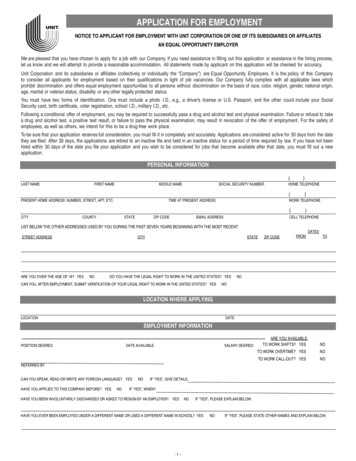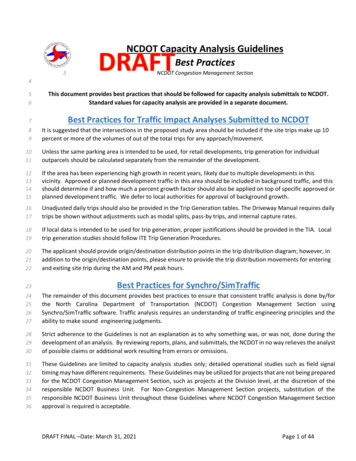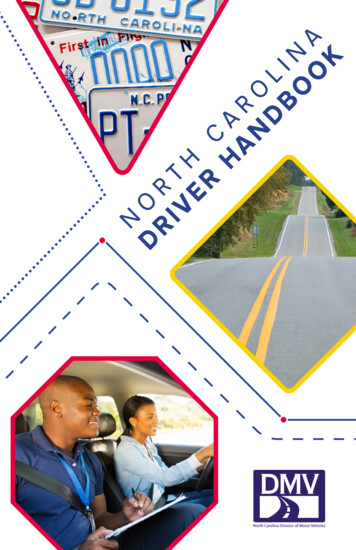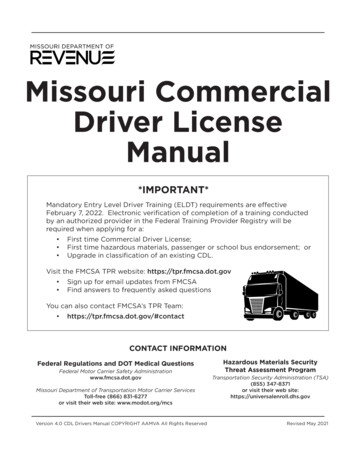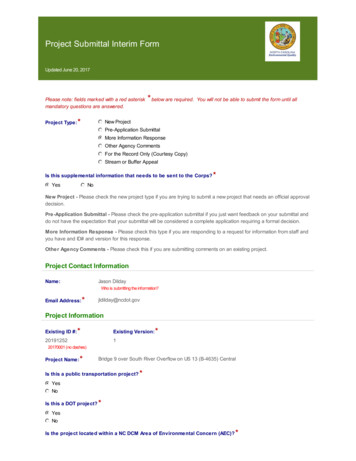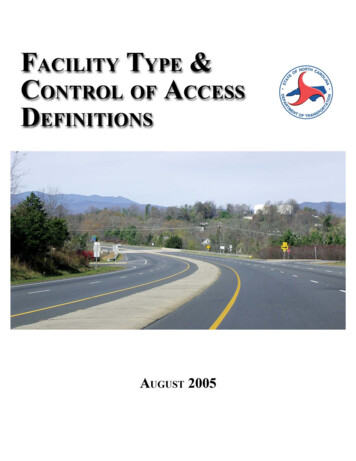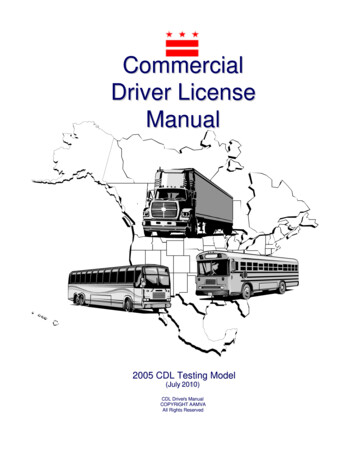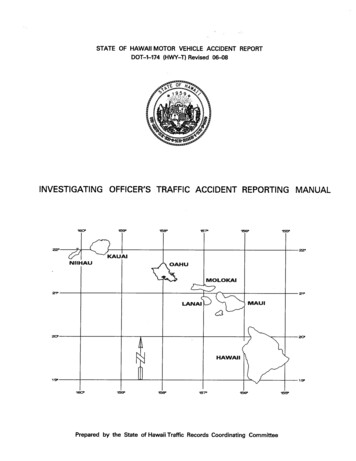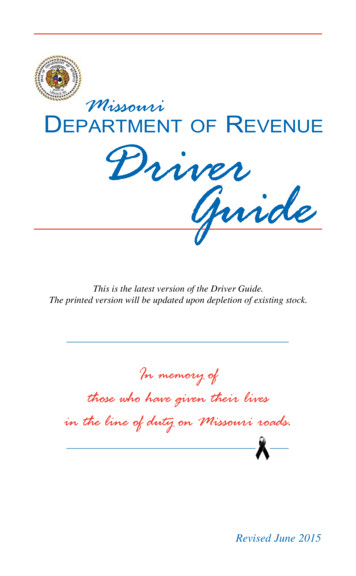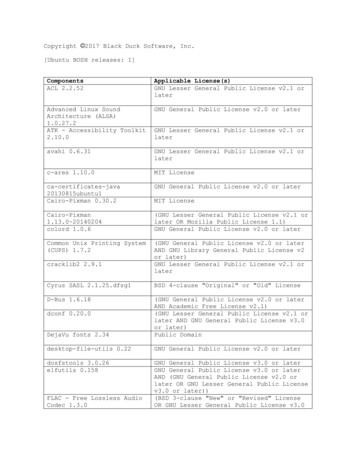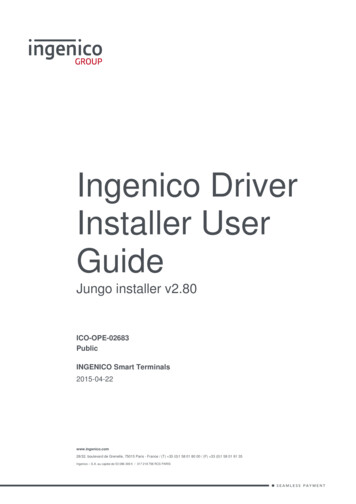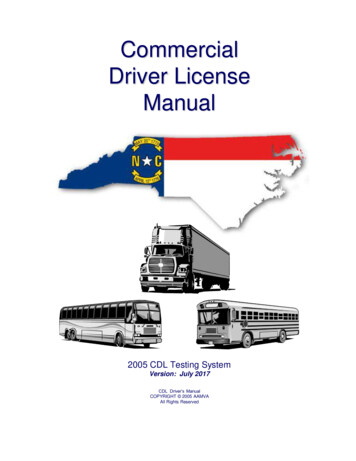
Transcription
CommercialDriver LicenseManual2005 CDL Testing SystemVersion: July 2017CDL Driver’s ManualCOPYRIGHT 2005 AAMVAAll Rights Reserved
This material is based upon work supported by the Federal Motor Carrier SafetyAdministration under Cooperative Agreement No. DTFH61-97-X-00017. Anyopinions, findings, conclusions or recommendations expressed in this publicationare those of the Author(s) and do not necessarily reflect the view of the FederalMotor Carrier Safety Administration.COPYRIGHT 2005 AAMVA. All rights reservedThis material has been created for and provided to State Driver License Agencies (SDLAs) by AAMVA for the purpose of educating DriverLicense applicants (Commercial or Non-Commercial). Permission to reproduce, use, distribute or sell this material has been granted to SDLAsonly. No part of this book may be reproduced or transmitted in any form or by any means, electronic or mechanical, including photocopying,recording, or by any information storage and retrieval system without express written permission from the author / publisher. Any unauthorizedreprint, use, distribution or sale of this material is prohibited.
STATE OF NORTH CAROLINADEPARTMENT OF TRANSPORTATIONROY COOPERJAMES H. TROGDON, IIIGOVERNORSECRETARYDear Commercial Driver:Thank you for spending the time to study this Commercial Driver’s Manual and to learnabout North Carolina’s motor vehicle laws regarding commercial vehicles and theiroperation. Keeping vehicles in safe operating order and drivers well trained is the best waywe can protect all motorists on the state’s roadways.As you begin your preparation to take the Commercial Driver License exam, pleaseremember that you are an important part of North Carolina’s commerce. Every passengeryou transport and every load you truck is placed in your care with the trust that you will seethem to their destination safely. We count on you to do just that.I trust that you will take your work seriously, obey the traffic laws and drive safely at alltimes.Please remember that you have my every wish for successful, safe travels.Sincerely,Torre J. JessupCommissionerMailing Address:NC DIVISION OF MOTOR VEHICLESOFFICE OF THE COMMISSIONER3101 MAIL SERVICE CENTERRALEIGH. NC 27699-3101Telephone: (919) 861-3015Website: www.ncdot.govLocation:DMV HEADQUARTERS BUILDING1100 NEW BERN AVENUERALEIGH, NC 27697
In January 2015, an RV pulled into a truck stop in Virginia. Observant professional truck driver Kevin Kimmel recognizedsuspicious activity around that RV, which had pulled back by the truck line, and decided something was off. Instead of turning ablind eye, he made a call that brought law enforcement out to the scene within a few minutes. After interviewing the occupantsof the vehicle, they discovered that a young woman, 20 years old, had been kidnapped from Iowa two weeks prior. She hadbeen beaten, raped, her whole body burned by instruments heated on the RV stove, branded and starved. She was being sold byher traffickers, Laura Sorenson and Aldair Hodza, through sex ads on Craigslist, where men were purchasing her and then arrivingat the RV to rape her. She was dying from malnutrition and the torture she was subjected to had the call not been made thatbrought law enforcement out to that truck stop, doctors said she would have died within the next few days. Now a recoveringsurvivor, this young woman calls Kimmel her guardian angel. He calls himself a Trucker Against Trafficking.Truckers Against Trafficking is a non-profit organization that has been working with the trucking industry since 2009 to providethe needed training and tools to enable members of the industry to both recognize human trafficking when they see ithappening and to know what actions to take to enable law enforcement to effectively fight this crime. Through this training andthese tools, truckers are becoming Everyday Heroes like Kevin Kimmel, who was also named TAT’s 2015 Harriet Tubman Awardwinner.One of the tools TAT provides is a wallet card with red flagsto look for, questions to ask if you suspect someone is avictim and actionable information to report. This wallet cardis available by App, from the appropriate App Store, on allsmart phones, whether Android, iPhone or Windows format,as well as by emailing tat.truckers@gmail.com, for a versionto carry in your wallet.Additionally, TAT provides a powerful, 26-minute trainingvideo on its website (www.truckersagainsttrafficking.org),which, when watched along with taking and passing a short test, certifies drivers as TAT-Trained, a designation which can go onyour resume. Because professional drivers often find themselves in locations frequented and exploited by human traffickers,they are in a unique position to recognize the signs of human trafficking and to make the call that can lead to victim recovery andperpetrator arrests. Get your wallet card today. Be an Everyday Hero! Make the call (1-888-3737-888); save lives!
Table of ContentsIntroduction .1-1Driving Safely .2-1Transporting Cargo Safely .3-1Transporting Passengers Safely.4-1Air Brakes .5-1Combination Vehicles .6-1Doubles and Triples .7-1Tank Vehicles .8-1Hazardous Materials.9-1School Bus .10-1Vehicle Vehicle Inspection .11-1Basic Vehicle Control Skills Test .12-1On-Road Driving .13-1
THIS PAGE INTENTIONALLY LEFT BLANK
Commercial Driver’s License Manual – 2005 CDL Testing SystemSection 1INTRODUCTIONThis Section Covers Commercial Driver License TestsMedical RequirementsDriver DisqualificationsOther Safety RulesInternational Registration ProgramThere is a federal requirement that each state haveminimum standards for the licensing of commercialdrivers.This manual provides driver license testinginformation for drivers who wish to obtain acommercial learner’s permit (CLP) or a commercialdriver license (CDL). This manual does NOTprovide information on all the federal and staterequirements needed before you can drive acommercial motor vehicle (CMV). If you requireadditional information, please call (919) 715-7000.You must have a CDL to operate:Any single vehicle with a gross vehicle weight rating(GVWR) of 26,001 pounds or more.A combination vehicle with a gross combinationweight rating (GCWR) of 26,001 or more pounds,provided the GVWR of the vehicle(s) being towed isin excess of 10,000 pounds.A vehicle designed to transport 16 or morepassengers (including the driver).Any size vehicle which requires hazardous materialplacards or is carrying material listed as a selectagent or toxin in 42 CFR part 73. Federalregulations through the Department of HomelandSecurity require a background check andfingerprinting for the Hazardous universalenroll.dhs.gov for more information.more than 10,000 pounds. Most Class A vehiclesare trucks such as truck-tractor/semi-trailer or truckand trailer combinations. However, tractor-trailerbuses may be found in a few communities. Driving aClass A vehicle requires considerably more skill andknowledge than driving vehicles in Classes B and C.Since these skills include those required to drive a Band C vehicle, a driver who has a Class A licensealso may drive vehicles in Classes B and C.Class BHeavy Straight Vehicles. Any singlevehicle with a GVWR of 26,001 or more pounds fallsin Group B, or any such vehicle towing anothervehicle not in excess of 10,000 pounds GVWR.Class B includes straight trucks and large buses,including articulated buses. Safely driving theseheavy vehicles requires considerably moreknowledge and skill than driving the small trucks andbuses found in Class C. Since they include the skillsrequired to drive Class C vehicles, drivers who havequalified for a Class B license may also drive vehiclesin Class C.Class C Small Vehicles. Any single vehicle with aGVWR less than 26,001 pounds falls in Group C, orany such vehicle towing another vehicle not inexcess of 10,000 pounds GVWR. However, vehiclesof this size are included in the CDL program only ifthey are: 1) Designed to carry 16 or more passengersincluding the driver, or (2) Used to transporthazardous materials in quantities requiringplacarding under the Hazardous MaterialsRegulations (49 CFR Part 172, Subpart F) or iscarrying material listed as a select agent or toxin in42 CFR part 73.There are a great variety of vehicles in Class C.Some rather large Class C vehicles may requiremore skill and knowledge to operate than do thesmaller ones. However, the licensing category isbased principally on the type of cargo carried.Because of the seriousness of an accident involvinghazardous material or human passengers, the safeoperation of even the smaller vehicles in Class Crequires special knowledge and the drivers of thesevehicles must have a CDL.CDL ClassificationsThe CDL vehicle classification included in thefederal standard, together with the type of cargo tobe transported, determine what type of CDL licenseand endorsement an applicant must apply for.There are three basic vehicle classes or groups:Class A Combination Vehicles. Any combinationof vehicles with gross combination weight rating(GCWR) of 26,001 or more pounds falls in Group Aprovided the GVWR of the vehicle(s) being towed isSection 1 - IntroductionVersion: July 2017Page 1-1
Commercial Driver’s License Manual – 2005 CDL Testing SystemCDL Endorsements & RestrictionsEndorsementsAll commercial drivers who drive certain types ofvehicles or haul certain types of cargo must addendorsements to their CDL license and/orCommercial Learner’s Permit (CLP) to show thatthey have the specialized knowledge required forthese operations. There are six kinds of CDLendorsements that may be required, depending onthe vehicle or type of cargo.NOTE: The only endorsements that may beadded to a Commercial Learner’s Permit (CLP)are:- Passenger (P);- School bus (S); and- Tank vehicle (N).Double and Triple Trailers (T). Many drivers whoare qualified to drive Class A vehicles may wish topull double or triple trailers. Research shows thatconsiderable additional knowledge and skill isnecessary to safely pull double and triple trailers invarious traffic conditions and driving environments.Consequently, adding the endorsement to thelicenses of Class A drivers is necessary if they wishto pull double or triple trailers. A special knowledgeexamination on the problems associated with pullingmultiple trailers must be passed.Tank Vehicle (N). Drivers of any commercial motorvehicle that is designed to transport any liquid orgaseous materials within a tank or tanks having anindividual rated capacity of more than 119 gallonsand an aggregate rated capacity of 1,000 gallons ormore that is either permanently or temporarilyattached to the vehicle or the chassis must obtain thisendorsement. Applies to Class A, B and C (onlyapplicable to Class C if the vehicle is haulinghazardous materials) vehicles. Liquids in bulk causedriving control problems because the cargo is heavy,prone to shifting, and has a high center of gravity.These drivers must pass a special knowledgeexamination on the problems posed by large volumeliquid cargos to add the endorsement to theirCDL/CLP.Passengers (P). Drivers who wish to drive a vehiclehaving a design capacity to carry 16 or more people,including the driver, must add a passengerendorsement to their CDL/CLP. They must pass aspecial knowledge examination on safetyconsiderations when transporting passengers andmust pass skills tests in a passenger vehicle. Theendorsement applies to applicants who wish to drivea bus in any class (A, B, or C).Section 1 - IntroductionVersion: July 2017Hazardous Materials (H). Any driver, regardless ofthe vehicle Class/Group (A, B, or C) who wishes tohaul any material that has been designated ashazardous under 49 U.S.C. 5103 and is required tobe placarded under subpart F of 49 CFR part 172; orany quantity of a material listed as a select agent ortoxin 42 CFR Part 73 must add a hazardousmaterials endorsement to their CDL. S/he must passa special written examination on how to recognize,handle, and transport hazardous materials.The Transportation Security Administration (TSA)and the US Department of Transportation requirebackground checks on commercial drivers who arecertified to transport hazardous materials. Thebackground checks include a review of criminal,immigration and FBI records. If the driver is foundto represent a security threat, TSA will notify theperson and the state will deny issuance of anendorsement.Combination Hazardous Materials and TankVehicle (X). Drivers of tank vehicles who haulhazardous materials or waste in amounts requiringplacards must add an X endorsement to their CDL,showing that they have passed the specialknowledge examinations for both tank vehicles andhazardous materials.School Buses (S). Drivers who wish to drive aschool bus, must add a school bus endorsement totheir CDL/CLP. They must pass a special knowledgeexamination on safety considerations whentransporting passengers in a school bus and mustpass skills tests in a school bus. The endorsementapplies to applicants who wish to drive a school busin any class (A, B, or C).NOTE: Administered by School Bus and TrafficSafety Section ONLY. Contact (919) 715-7000 formore information.RestrictionsRestrictions may be added to Commercial DriverLicenses/Permits based upon the type of vehicle andequipment that the driver uses for the Skills Test.There are ten standardized restriction codes.NOTE: If a CLP is issued with a Passenger (P) or aSchool Bus (S) endorsement, it must also contain a(P) – No passengers in a CMV bus restriction.If a CLP is issued with a Tanker (N) endorsement, itmust also contain a (X) – No cargo in a CMV tankvehicle.Page 1-2
Commercial Driver’s License Manual – 2005 CDL Testing System(E) - No manual transmission. If an applicantperforms the skills test in a vehicle equipped with anautomatic transmission, the State must indicate onthe CDL, if issued, that the person is restricted fromoperating a CMV equipped with a manualtransmission. For the purposes of the skills test andthe restriction, an automatic transmission includesany transmission not operating fully on the gear shiftand clutch principle.(K) - Intrastate only: If an applicant certifies theirstatus as either Non-Excepted Intrastate orExcepted Intrastate, the state must indicate on theCDL, if issued, that person is restricted fromoperating a CMV in interstate commerce.(L) - No Air brake equipped CMV: If an applicantdoes not take or fails the air brake component of theknowledge test, or performs the skills test in avehicle not equipped with air brakes, the State mustindicate on the CLP or CDL, if issued, that theperson is restricted from operating a CMV equippedwith any type of air brakes. For the purposes of theskills test and the restriction, air brakes include anybraking system operating fully or partially on the airbrake principle.(M) - No Class A passenger vehicle: If anapplicant applying for a passenger endorsementperforms the skills test in a passenger vehiclerequiring a Group B CDL, the State must indicate onthe CDL, if issued, that the person is restricted fromoperating a passenger vehicle requiring a Group ACDL.(N) - No Class A and B passenger vehicle: If anapplicant applying for a passenger endorsementperforms the skills test in a passenger vehiclerequiring a Group C CDL, the State must indicate onthe CDL, if issued, that the person is restricted fromoperating a passenger vehicle requiring a Group Aor B CDL(O) - No tractor trailer CMV: If an applicantperforms the skills test in a combination vehicle fora Group A CDL with the power unit and towed unitconnected with a pintle hook or other non-fifth wheelconnection, the State must indicate on the CDL, ifissued, that the person is restricted from operatinga tractor-trailer combination connected by a fifthwheel that requires a Group A CDL.An applicant who passes a skills test using acombination vehicle that is NOT a Truck TractorSemi-Trailer combination, but is otherwiseequipped with a fifth wheel, will be issued a CDLwith an “O” restriction.Section 1 - IntroductionVersion: July 2017(P) - No passengers in CMV bus: A CLP holderwith a P endorsement is prohibited from operating aCMV carrying passengers, other than Federal/Stateauditors and inspectors, test examiners, othertrainees, and the CDL holder accompanying theCLP holder as prescribed by § CFR 383.25(a)(1) ofthis part.A CLP holder with a S endorsement is prohibitedfrom operating a school bus with passengers, otherthan Federal/State auditors and inspectors, testexaminers, other trainees, and the CDL holderaccompanying the CLP holder as prescribed by §CFR 383.25(a)(1) of this part.(V) - Medical Variance: If the State is notifiedaccording to § 383.73(o)(3) that the driver has beenissued a medical variance, the State must indicatethe existence of such a medical variance on theCDLIS driver record and the CDL document, ifissued, using the restriction code ‘‘V’’ to indicatethere is information about a medical variance on theCDLIS driver record.(X) - No cargo in CMV tank vehicle: A CLP holderwith an N endorsement may only operate an emptytank vehicle and is prohibited from operating anytank vehicle that previously contained hazardousmaterials that has not been purged of any residue.(Z) - No full air brake equipped CMV: If anapplicant performs the skills test in a vehicleequipped with air over hydraulic brakes, the Statemust indicate on the CDL, if issued, that the personis restricted from operating a CMV equipped withany braking system operating fully on the air brakeprinciple. For the purposes of the skills test and therestriction, air over hydraulic brakes includes anybraking system operating partially on the air brakeand partially on the hydraulic brake principle.To Get a CDL or CLPTo get a CDL or CLP, you must pass knowledge andskills tests. This manual will help you pass the tests,however, it is not a substitute for a truck drivertraining class or program. Formal training is themost reliable way to learn the many special skillsrequired for safely driving a large commercialvehicle and becoming a professional driver in thetrucking industry. Figure 1.1 helps you determine ifyou need a CDLPage 1-3
Commercial Driver’s License Manual – 2005 CDL Testing SystemFigure 1.1NOTE:A bus may be Class A, B, or C depending on whether the GVWR is over 26,001 pounds or is a combination vehicle.Section 1 - IntroductionVersion: July 2017Page 1-4
Commercial Driver’s License Manual – 2005 CDL Testing System1.1 – Commercial Driver License Tests1.1.1 – Knowledge TestsYou will have to take one or more knowledge tests, depending on what class of license and what endorsementsyou need. The CDL knowledge tests include:The general knowledge test, taken by all applicants.The passenger transport test, taken by all bus driver applicants.The air brakes test, which you must take if your vehicle has air brakes, including air over hydraulic brakes.The combination vehicles test, which is required if you want to drive combination vehicles.The hazardous materials test, required if you want to haul hazardous materials as defined in 49 CFR 383.5.In order to obtain this endorsement you are also required to pass a Transportation Security Administration (TSA)background check.The tank vehicle test, required if you want to haul any liquid or gaseous materials in a tank or tanks havingan individual rated capacity of more than 119 gallons and an aggregate rated capacity of 1,000 gallons or morethat is either permanently or temporarily attached to the vehicle or chassisThe doubles/triples test, required if you want to pull double or triple trailers.The School Bus test, required if you want to drive a school bus.(NOTE: Administered by School Bus and Traffic Safety Section ONLY. Contact (919) 715-7000.)Only one attempt at each knowledge test is allowed per day. If after three attempts, you have not passed thegeneral knowledge test, another application fee will be required to allow three more attempts. Similaly, eachthree attempts thereafter require another application fee.You do not need an appointment for knowledge tests.NOTE: All test scores are valid 90 days from the test date in NCDMV computer files.Section 1 - IntroductionVersion: July 2017Page 1-5
Commercial Driver’s License Manual – 2005 CDL Testing SystemWhat Sections Should You Study?LICENSEENDORSEMENTTYPE2XXX3XXXXXX4School BusXPassengerHazardousMaterialsClass CXTank VehiclesClass BXDouble / TripleClass ASections to tudy section 5 if you plan to operate vehiclesequipped with air brakes.Figure 1.2 – What to StudySection 1 - IntroductionVersion: July 2017Page 1-6
Commercial Driver’s License Manual – 2005 CDL Testing System1.1.2 – Skills TestsIf you pass the required knowledge test(s), you can take the CDL skills test when you are eligible. The CDLSkills Test consists of three segments: Vehicle inspection, basic vehicle control, and on-road driving. You musttake the segments in the order listed and must pass each one before moving to the next. You must take thesetests in the type of vehicle for which you wish to be licensed. Any vehicle that has components marked orlabeled cannot be used for the CDL Skills Test.Vehicle Inspection. You will be tested to see if you know whether your vehicle is safe to drive. You will be askedto do a Vehicle inspection of your vehicle. You must point to/touch and name the item you are inspecting andexplain to the examiner what you would inspect and why.Basic Vehicle Control. You will be tested on your skill to control the vehicle. You will be asked to move yourvehicle forward, backward, and turn it within a defined area. These areas may be marked with traffic lanes,cones, barriers, or something similar. The examiner will tell you how each control test is to be done.On-road Test. You will be tested on your skill to safely drive your vehicle in a variety of traffic situations. Thesituations may include left and right turns, intersections, railroad crossings, curves, up and down grades, singleor multi-lane roads, streets, or highways. The examiner will tell you where to drive.Figure 1.2 details which sections of this manual you should study for each particular class of license and foreach endorsement.1.2 – Medical Documentation RequirementsStarting January 30, 2012 and no later than January 30, 2014, if you are applying for a Commercial Learner’sPernit; or are renewing, upgrading, adding endorsements to a CDL; or transferring a CDL from another state,you are required to provide information to NC DMV regarding the type of commercial motor vehicle operationyou drive in or expect to drive in with your CDL. Drivers operating in certain types of commerce will be requiredto submit a current medical examiner’s certificate and/or any medical variance documents that you have beenissued (i.e. Vision, Skills Performance or Diabetic waivers, or other exemptions) to NC DMV to obtain a “certified”medical status as part of your driving record. You may contact NC DMV at (919) 715-7000 or visit NC DMV’swebpage https://www.ncdot.gov/dmv/driver/commercial/ to obtain information regarding the requirement forsubmitting these documents.If you are required to have a ”certified” medical status and fail to provide and keep up-to-date your medicalexaminer’s certificate you become ”not-certified” and may lose your CDL.For the purpose of complying with the new requirements for medical certification, it is important to know howyou are using the CMV. The following information will help you decide how to self-certify:1.2.1 – Interstate or Intrastate CommerceDo you, or will you, use a CDL to operate a CMV in interstate or intrastate commerce?Interstate commerce is when you drive a CMV:From one State to another State or a foreign country;Between two places within a State, but during part of the trip, the CMV crosses into another State or foreigncountry; orBetween two places within a State, but the cargo or passengers are part of a trip that began or will end in anotherState or foreign country.Intrastate commerce is when you drive a CMV within a State and you do not meet any of the descriptionsabove for interstate commerce.If you operate in both intrastate commerce and interstate commerce, you must choose interstate commerce.Section 1 - IntroductionVersion: July 2017Page 1-7
Commercial Driver’s License Manual – 2005 CDL Testing System1.2.2 – Inter/Intrastate Commerce: Status Non-excepted or Excepted?Once you decide whether you will operate in interstate commerce or intrastate commerce, you must decidewhether you will operate (or expect to operate) in a non-excepted or excepted status. This decision will tell youto which of the four types of commerce you must self-certify.Interstate Commerce:You operate in excepted interstate commerce when you drive a CMV in interstate commerce only for thefollowing excepted activities:To transport school children and/or school staff between home and school;As Federal, State or local government employees;To transport human corpses or sick or injured persons;Fire truck or rescue vehicle drivers during emergencies and other related activities;Primarily in the transportation of propane winter heating fuel when responding to an emergency conditionrequiring immediate response such as damage to a propane gas system after a storm or flooding;In Response to a pipeline emergency condition requiring immediate response such as a pipeline leak or rupture;In custom harvesting on a farm or to transport farm machinery and supplies used in the custom harvestingoperation to and from a farm or to transport custom harvested crops to storage or market;Beekeeper in the seasonal transportation of bees;Controlled and operated by a farmer, but is not a combination vehicle (power unit and towed unit), and is usedto transport agricultural products, farm machinery or farm supplies (no placardable hazardous materials) to andfrom a farm and within 150 air-miles of the farm;As a private motor carrier of passengers for non-business purposes; orTo transport migrant workers.If you answered yes to one or more of the above activities as the only operation in which you drive, you operatein excepted interstate commerce and do not need a Federal medical examiner’s certificate.If you answered no to all of the above activities, you operate in non-excepted interstate commerce and arerequired to provide a current medical examiner’s certificate (49 CFR 391.45),commonly referred to as a medicalcertificate or DOT card, to NC DMV. Most CDL holders who drive CMVs in interstate commerce are nonexcepted interstate commerce drivers.If you operate in both excepted interstate commerce and non-excepted interstate commerce, you mustchoose non-excepted interstate commerce to be qualified to operate in both types of interstate commerce.Intrastate Commerce:You operate in excepted Intrastate commerce when you drive a CMV only in intrastate commerce activitiesfor which your State of licensure has determined do not require you to meet the State’s medical certificationrequirements.You operate in non-excepted intrastate commerce when you drive a CMV only in intrastate commerce andare required to meet your State of licensure’s medical certification requirements (contact your SDLA about theirrequirements).If you operate in both excepted intrastate commerce and non-excepted intrastate commerce, you mustchoose non-excepted intrastate commerce.Section 1 - IntroductionVersion: July 2017Page 1-8
Commercial Driver’s License Manual – 2005 CDL Testing System1.2.3 – Self-Certification StatementsWhen completing an application for your CDL, you will be required to check the box next to the statement thatdescribes your status. The actual statements on your application may vary from those shown below: Interstate non-excepted: I certify that I operate or expect to operate in interstate commerce, that I amsubject to and meet the Federal DOT medical card requirements under 49 CFR part 391; and that I amrequired to obtain a medical examiner’s certificate. Interstate excepted: I certify that I operate or expect to operate in interstate commerce, but engageexclusively in transportation or operations excepted under 49 CFR §§390.3(f), 391.2, 391.68 or 398.3 fromall or parts of the qualification requirements of 49 CFR part 391; and that I am not required to obtain amedical examiner’s certificate. Intrastate non-excepted: I certify that I operate or expect to operate entirely in intrastate commerce, that
3101 MAIL SERVICE CENTER RALEIGH. NC 27699-3101 . Telephone: (919) 861-3015 . Website: www.ncdot.gov. Location: DMV HEADQUARTERS BUILDING 1100 NEW BERN AVENUE . knowledge and skill than driving the small trucks and buses found in Class C. Since they include the skills required to drive Class C vehicles, drivers who have .
